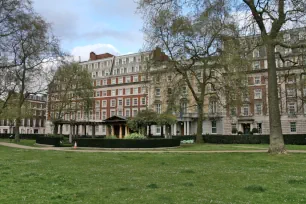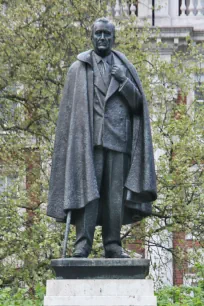Grosvenor Square is the largest square in Mayfair, an exclusive district in central London. The square has been associated with Americans ever since the eighteenth century, when America’s first Ambassador to the U.K. lived here.
History

Grosvenor Square was created in 1720 as the centerpiece of the development of the Grosvenor Estate, a formerly rural area that was speculatively developed by the Grosvenor family into an upscale neighborhood. In 1725 John Alston created a design for a central, oval-shaped garden. Its layout was based on a former design submitted by Thomas Fairchild, a proponent of rural, wilderness-like gardens.
The Garden Oval, as it was known, was surrounded by low hedges and the lawns were dotted with dwarf trees. At its center stood an equestrian statue of King George I, one of the first such statues in the city. The garden was surrounded by railings and was only accessible to keyholders. They had to live around the garden and pay for its maintenance.
During the Second World War, the iron railing was removed and after the war the square opened to the public. The low shrubs and dwarf trees have long been replaced by lawns that are dotted with large Linden trees.



Little America
Grosvenor Square is sometimes called ‘Little America’ for its connection with the United States. John Adams, the second president of the U.S. lived at 9, Grosvenor Square from 1785 to 1788 when he was the ambassador to the United Kingdom. In 1938 the American Embassy was established at the square. During the war Dwight D. Eisenhower had his headquarters opposite the embassy, which gave the square another nickname: ‘Eisenhower Platz’.
In 1960 the embassy moved into a modern building designed by the Finnish architect Eero Saarinen, which occupies the west side of the Grosvenor Square. The massive building is guarded like a fortress, and the street between the embassy and the square has even been blocked off. The bunker-like embassy building contrasts with the elegant facades from the eighteenth and nineteenth centuries that surround the square. It has received heritage protection, so it will not be demolished even though the embassy moved to a site in Nine Elms, near the Thames, where a new highly-secured glass cube surrounded by a moat was built. The new embassy officially opened in January 2018.
Statues and Monuments
Grosvenor Square features quite a number of statues and memorials that remind us of the centuries-long American connection.
Presidential statues
The first such statue was unveiled here in 1948 and honors the wartime president Franklin Delano Roosevelt. It was created by the Scottish sculptor William Reid Dick and inaugurated in the presence of his widow Eleanor Roosevelt and King George VI. The statue was paid for by donations of people from all over the United Kingdom.
Dwight D. Eisenhower, who led D-Day from here, is also honored with a statue. It was unveiled in 1989 by Prime Minister Margaret Thatcher. The statue, which stands in front of the embassy building, was created by the American sculptor Robert Lee Dean.
Another former American President, Ronald Reagan, stands nearby, in the south-west corner of Grosvenor Square. His statue was unveiled on Independence Day in 2011 and was created by the American sculptor Chas Fagan. Near the statue is a piece of the Berlin Wall, a reference to the president’s role in the fall of the Iron Curtain.
Eagle Squadrons Memorial
The Eagle Squadrons Memorial commemorates the American volunteer fighter pilots who served in the RAF Eagle Squadron prior to the involvement of the United States in the Second World War in December 1941. The memorial shows a bronze eagle perched atop a column. It was created by the English sculptor Elizabeth Frink and unveiled in 1986.
September 11 Memorial Garden

The September 11 Memorial Garden on the east side of Grosvenor Square remembers those who lost their lives in the terrorist attacks on the U.S. on September 11, 2001. Three bronze plaques remember the 67 British citizens who died during the attacks.
The memorial consists of a wooden temple flanked by two pergolas embracing a small garden. In front of the temple is a memorial stone inscribed with an excerpt of a poem by Henry Van Dyke. A section of a steel girder from the WTC is buried underneath the stone.
- Next: Horse Guards
- More Sights & Attractions in London

